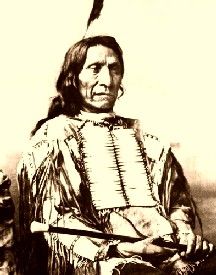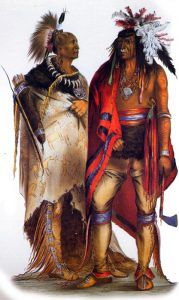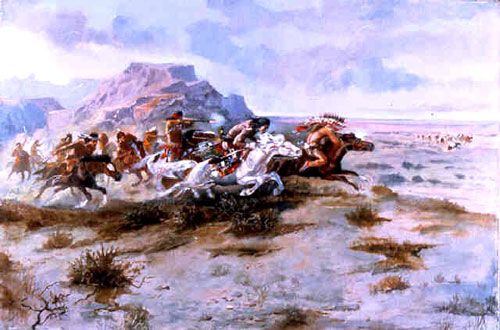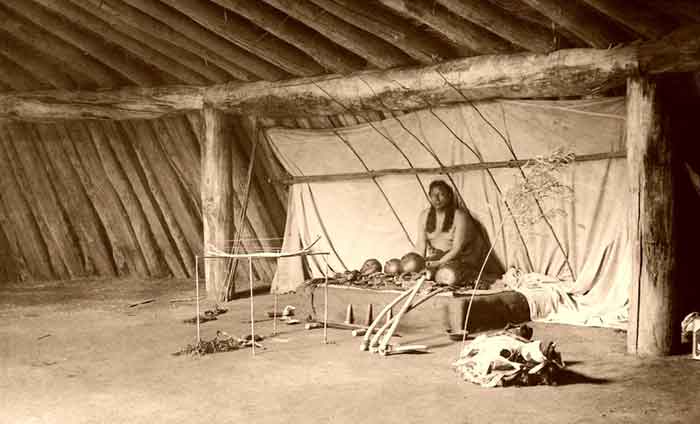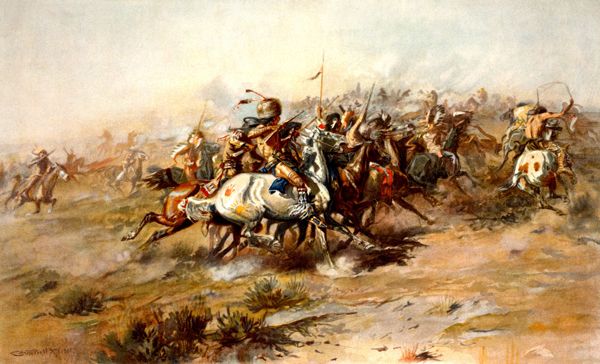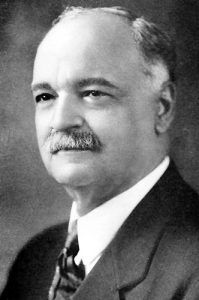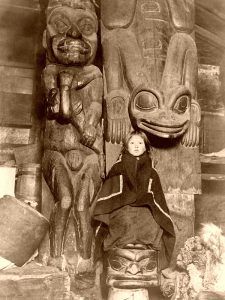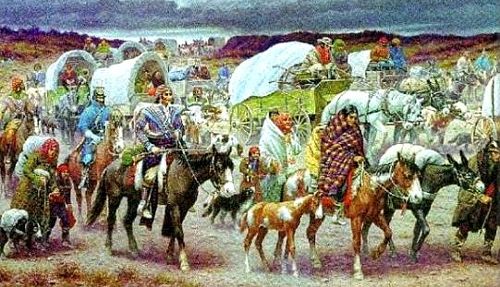
Cliff Palace is the largest cliff dwelling in North America. The structure, built by the Ancient Pueblo Peoples (also called the Anasazi), is located in Mesa Verde National Park in the southwest corner of Colorado. Photo from 1918
While Native American History is well documented, there are hundreds of interesting facts and trivia about our first Americans that many people are not aware of. This article examines a few of these.
~~~~~~~
According to the 2010 Census, 5.2 million people in the United States are identified as American Indian and Alaska Native, either alone or in combination with one or more other races, comprising 1.7% percent of the total population.
In the 2010 Census, 41% of the American Indian and Alaska Natives lived in the Western United States.
In the 2010 Census, of the American Indian and Alaska Natives, the largest tribe was the Cherokee, with a population of 819,000; followed by the Navajo, Choctaw, Mexican American Indian, Chippewa, Sioux, Apache, and Blackfeet.
Even though the vast majority of Native American live in the West today, the city with the largest American Indian population is New York City. This is followed by Los Angeles, California; Phoenix, Arizona, Anchorage, Alaska, and Albuquerque, New Mexico.
There were an estimated 18-20 million Native Americans living in the United States when Europeans first arrived.
Many historians believe that the United States Constitution was partially modeled after the Great Law of Peace, the constitution of the Iroquois Confederacy. In 1988, the United States Congress passed a resolution to recognize the influence of the Iroquois League upon the Constitution and Bill of Rights.
The oldest evidence of cotton cloth has been unearthed by archaeologists from caves in Mexico which date back as far as 8,000 years ago. Remains of cotton cloth and cotton bolls were found, making Native Americans the makers of the oldest cotton found to date.
During the days of the Old West, the Cheyenne, Apache, Navajo, Comanche, Sioux and Blackfeet were some of the major Indian nations. All lived in the area known as the Great Plains of North America, a vast area that stretches from the Mississippi River to the west of the continent.
The Cherokee, like many other tribes, traced their family relations matrilineally (through the mother.) As a result, there were many women who held leadership roles. Women of great influence became known as “Ghigau,” meaning Beloved Woman, the highest role to which a Cherokee woman could aspire. The name also translates into War Woman and was often awarded to courageous women warriors.
Viking explorers met Native Americans long before Christopher Columbus did. First making their way to North America in the 11th century, archaeological evidence suggests they encountered Native Americans some 500 years before Columbus arrived.
Countless Indian words have become a part of the English language. Just a few of these include barbecue, cannibal, caribou, chipmunk, chocolate, cougar, hammock, hurricane, mahogany, moose, opossum, potato, skunk, squash, toboggan, and woodchuck.
The 1894 Census Bureau estimated more than 40 “official” Indian Wars in the United States that cost the lives of some 19,000 white men, women and children and the lives of about 30,000 Indians. In addition to the official Indian Wars, there were hundreds of skirmishes between the settlers and the Native Americans that resulted when pioneers pushed westward, encroaching upon traditional Indian lands.
The Tiguex War was fought in the winter of 1540-41 by the army of Francisco Vasquez de Coronado against the 12 pueblos of Tiwa Indians along both sides of the Rio Grande in New Mexico. It was the first Indian War between Europeans and Native Americans in the American West.
The Navajo Nation has the largest American Indian population of all of the Native American reservations.
The first kidnapping in America took place when Italian explorers kidnapped an Indian child to bring to France in July 1524.
Centuries ago, Native Americans developed a process in which dried cactus-eating insects could be turned into red dye called cochineal. This Indian dye became one of the most important exports from the New World in the late 16th century. This red dye was highly valued by the European cloth industry for hundreds of years and was used to dye the red British uniforms in the American Revolution.
During the fall of the Romans, the Hohokam Indians were constructing the largest irrigation canal in North America. One of the most sophisticated irrigation networks ever created using pre-industrial technology, the Hohokam created 700 miles of canals by hand between 600-1450 AD in Arizona.
According to the Bureau of Indian Affairs, as of 2023, there are 574 federally-recognized Indian tribes. Additionally, there are at least 100 state-recognized tribes.
The Fetterman Massacre, called the “Battle of the Hundred Slain” by the Indians, occurred in Wyoming in 1866. It was the Army’s worst defeat on the Great Plains until the disaster on the Little Big Horn nearly ten years later.
Native American religions vary widely. For some, the Sun was the supreme god, others worshiped the goddess of death; others believed in an immaterial and almighty God, called Manitu.
Native Americans cultivated and developed many plants that are very important in the world today, including white and sweet potatoes, corn, beans, tobacco, chocolate, peanuts, cotton, rubber, and gum. They were also the first to make popcorn.
A far greater percentage of Native Americans, per capita, serve in the United States Military today than any other race or ethnic group.
Canoeing, snowshoeing, tobogganing, lacrosse, relay races, tug-of-wars, and ball games are just a few of the games early Native Americans played and still enjoy today. The word Toboggan comes from the Algonquian word odabaggan, which was invented by Indians in the eastern part of the United States to carry game over the snow.
Native Americans did not know the wheel and they did not have vehicles. To transport their goods while following the bison herds, they used the travois: two sticks joined to one end and diverging to the other. Before the arrival of the horses, smaller travois were used, dragged by dogs. Once horses were acquired, larger travois were attached with harnesses.
The first federal treaty enacted with Native Americans was with the Delaware Indians in 1787.
The first U.S. Census count in 1790 included slaves and free African-Americans, but Indians were not included.
Native Americans often served as guides in the exploration of America. Many of their trails became emigrant roads, which were later followed by the railroads.
From the animals introduced by Europeans, the horse was the most significant. During the 17th century, Spaniards introduced horses, which escaped in the now southwestern US. Native Americans quickly adapted to utilizing the horse, riding bareback, making it far easier in buffalo hunting as well as defending themselves or making attacks.
Iroquois tribes, including the Mohawk, Oneida, Onondaga, Cayuga and Seneca, fought on the British side, during the American Revolution (1775-1783). They received nothing from England for their participation and the United States took their territory. In revenge, Americans destroyed 40 Iroquois camps and the survivors had to take refuge in Canada.
Between 1820 and 1845, tens of thousands of Choctaw Cherokee, Chickasaw, Creek, and Seminole were forced from their lands under the Indian Removal Act and forced to walk to the westward to Indian Territory (Oklahoma). During their travels, some 25% died due to tough winters, hunger, disease, and exhaustion. By 1930, the territory east of the Mississippi River was virtually cleared of Indians.
In one of the Indian’s last armed efforts to preserve their way of life, the Battle of the Little Bighorn was fought in Montana on June 1876. Led by Lieutenant Colonel George A. Custer, he and his troops suffered a bitter defeat at the hands of the Sioux and Cheyenne warriors. The Battle of the Little Bighorn was the Indians’ greatest victory and the army’s worst defeat in the long and bloody Plains Indian War.
In 1820 more than 20,000 Indians lived in virtual slavery in the California missions.
The log cabin was an adaptation of the Indian log or longhouse.
Modern youth groups such as Boy Scouts, Girl Scouts, Campfire Girls, and the YMCA Indian Guides, all include programs based largely on Indian lore, arts and crafts, character building, and outdoor living.
A smallpox epidemic in 1834 reduced a Mandan Indian village from 1,600 to 130. In 1837, two-thirds of the 6,000 Blackfeet died of smallpox.
Prior to the arrival of the Europeans, American Indians were remarkably free of serious diseases and rarely died from illness. This; however, drastically changed as Europeans and colonists began to arrive, bringing with them measles, scarlet fever, typhoid, typhus, influenza, whooping cough, tuberculosis, cholera, diphtheria, chickenpox, and smallpox. Epidemics over the years killed millions of people, some reaching 80-90% of the population in the hardest hit areas.
Native Americans made root beer from Sassafras which predates colas and other popular sodas. During American Colonial times, root beer was introduced along with other beverages like Birch Beer, Sarsaparilla Beer, and Ginger Beer.
In the United States, the Navajo language is the most spoken Native American language, with over 200,000 speakers today.
President Hoover’s Vice-President, Charles Curtis, was of Kanza (Kaw) Indian descent and spent part of his early years on the Kaw Reservation at Council Grove, Kansas.
Many of the sites of old Indian villages, advantageously located on waterways and trails, would eventually become trading posts and then small villages as pioneers moved westward. Today, some are the sites of large cities such as of Chicago, Illinois; Detroit, Michigan; St. Louis, Missouri; Kansas City, Kansas; Pittsburgh, Pennsylvania; Pocatello, Idaho, and countless others.
There are approximately 296 spoken (or formerly spoken) indigenous languages north of Mexico. Hundreds of other have entirely ceased to exist.
Fur traders, who played an important role in exploring the west actively visited and traded with Native Americans. Their reports, unfortunately for the Indians, were instrumental in encouraging land-hungry and adventurous people to move westward.
American Indians developed and often communicated with sign language. This system of hand signals was developed to facilitate trade and communication between tribes, and later with trappers and traders.
Native Americans were some of the first developers of anesthetics, using coca, peyote, datura and other plants for partial or total loss of sensation or consciousness during surgery. Immigrant doctors who came to America were unaware of these techniques until the mid-19th century. Before this, they performed surgery with no more anesthetic than alcohol or knocked the patient out.
The Pilgrim colony of Plymouth, Massachusetts, was established with the help of the Wampanoag Indians. The Indians showed them how to cultivate the land and in return, were given guns and steel tools.
In 1850, there were an estimated 20,000,000 buffalo on the plains between Montana and Texas, for which the Plains tribes depended upon. Fifteen years later, they had been almost exterminated by sports and hide hunters.
The indigenous people of the northwest consider that the first totem pole was a gift from Raven, their cultural hero. Totem poles were often used as family crests denoting the tribe’s descent from an animal such as the bear, raven, wolf, salmon, or killer whale.
Native Americans were the first people to make maple syrup, in much the same way is it is made today.
For many years, scientists have thought that the first Americans came to North America from Asia 13,000 years ago by way of the Bering Strait during the last ice age. However, archaeologists have since found traces of an even earlier people in central Texas, which are some 15,500 years old. These finds cast serious doubt on the “Bering Strait land bridge theory” as the land bridge was impassable at that time. Native American tradition and oral stories say that they have always been here. In any event, Native Americans have occupied North America longer than anyone lived in England (12-15,000 years) or northern Europe (10,000 years).
One of the first treaties between colonists and Native Americans was signed in 1621 when the Plymouth Pilgrims enacted a peace pact with the Wampanoag Tribe, with the aid of Squanto, an English speaking Native American.
In the 1752 census, 147 “Indian” slaves — 87 females and 60 males — were listed as living in French households in what would later be called Illinois. These people were from different cultural groups than the local Native American population and were often captives of war.
When European colonists began to arrive in what would become the United States, the Indians collaborated with them. Jamestown, Virginia, the first British settlement in America, was built with the help of the Powhatan Indians; without which they very well might not have survived the tough winter of 1607-1608.
The first Indian reservation in North America was established by the New Jersey Colonial Assembly on August 1, 1758.
The Creek War was instigated by General Andrew Jackson who sought to end Creek resistance in ceding their lands to the US government. The Creek Nation was defeated and at the Treaty of Fort Jackson, the Creek lost 14 million acres, or two-thirds of their tribal lands. To count the Creek dead, whites cut off their noses, piling 557 of them. They also skinned their bodies to tan as souvenirs. This was the single largest cession of territory ever made in the southeast.
There are about 150 Native American languages in the United States and Canada.
Despite the Supreme Court’s rulings in 1831 and 1832 that the Cherokee had a right to stay on their lands, President Andrew Jackson sent federal troops to forcibly remove almost 16,000 Cherokee who had refused to move westward under the unrecognized Treaty of New Echota (1835) and had remained in Georgia. In May 1838 American soldiers herded most into camps where they remained imprisoned throughout the summer and where at least 1,500 perished. The remainder began an 800-mile forced march to Oklahoma that fall on what has become known as the Trail of Tears. In all some, 4,000 Cherokee died during the removal process.
In 1513 Florida, Spaniards had taken a number of Natives to cultivate the land. These Indians were also forced to renounce their religion and accept Christianity.
Many Indian Nations were farming as early as 1200 BC.
Some Indian villages and cities housed up to 50,000 people. One example is Cahokia in Illinois.
By the time Christopher Columbus returned to the New World for the second time, Old World diseases had killed two-thirds of the Native Americans they had previously encountered.
California has the greatest population of Native Americans today at 14%, followed by Oklahoma, Arizona, Texas, and New York.
Most Indian tribes believed in the power of the dreams and visions, which have long been considered revelations made by gods. Those who wished to activate this capacity, especially shamans, would devote themselves to magic dances, rites, and ceremonies which were thought to invoke the spirits.
The Cherokee had a written language before the Europeans arrived on the continent.
In 1967, a group of “Red Power” activists occupied the island of Alcatraz in California.
During World War II, the Japanese Army could not break the secret code of the U.S. Military. The code was simply a group of Navajo volunteers speaking their Native American language on their field radios.
More than 50% of state names are based on Native American words. Twenty-seven state names have Indian meanings including Utah, named for the Ute tribe; Kentucky, which means planted field in the Iroquois language; Kansas, named for the Kanza (Kaw) tribe; and dozens more.
American Indians were not given U.S. citizenship on a mass scale until 1924.
Compiled by Kathy Weiser/Legends of America, updated November 2023.
Also See:
Native American Photo Galleries

